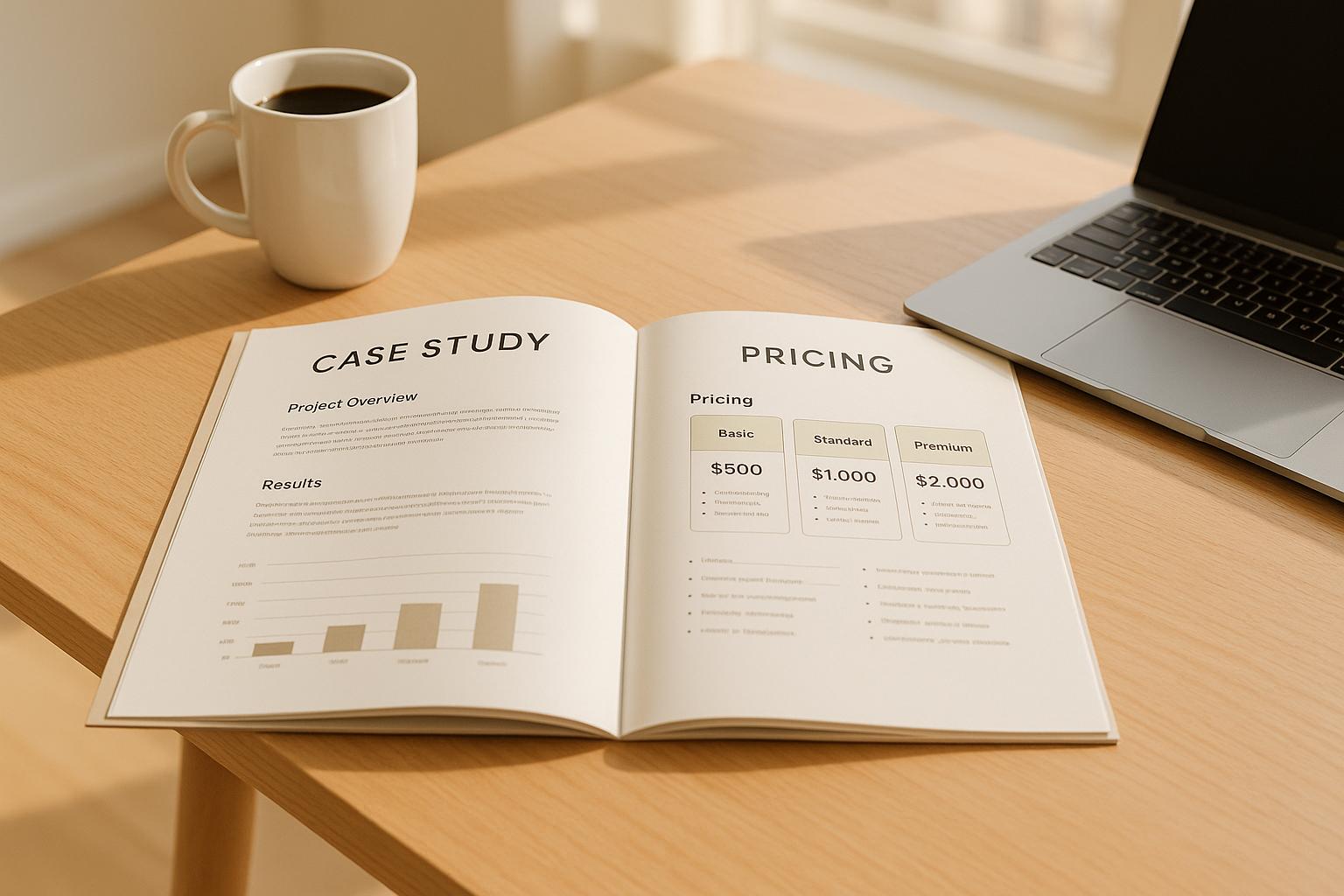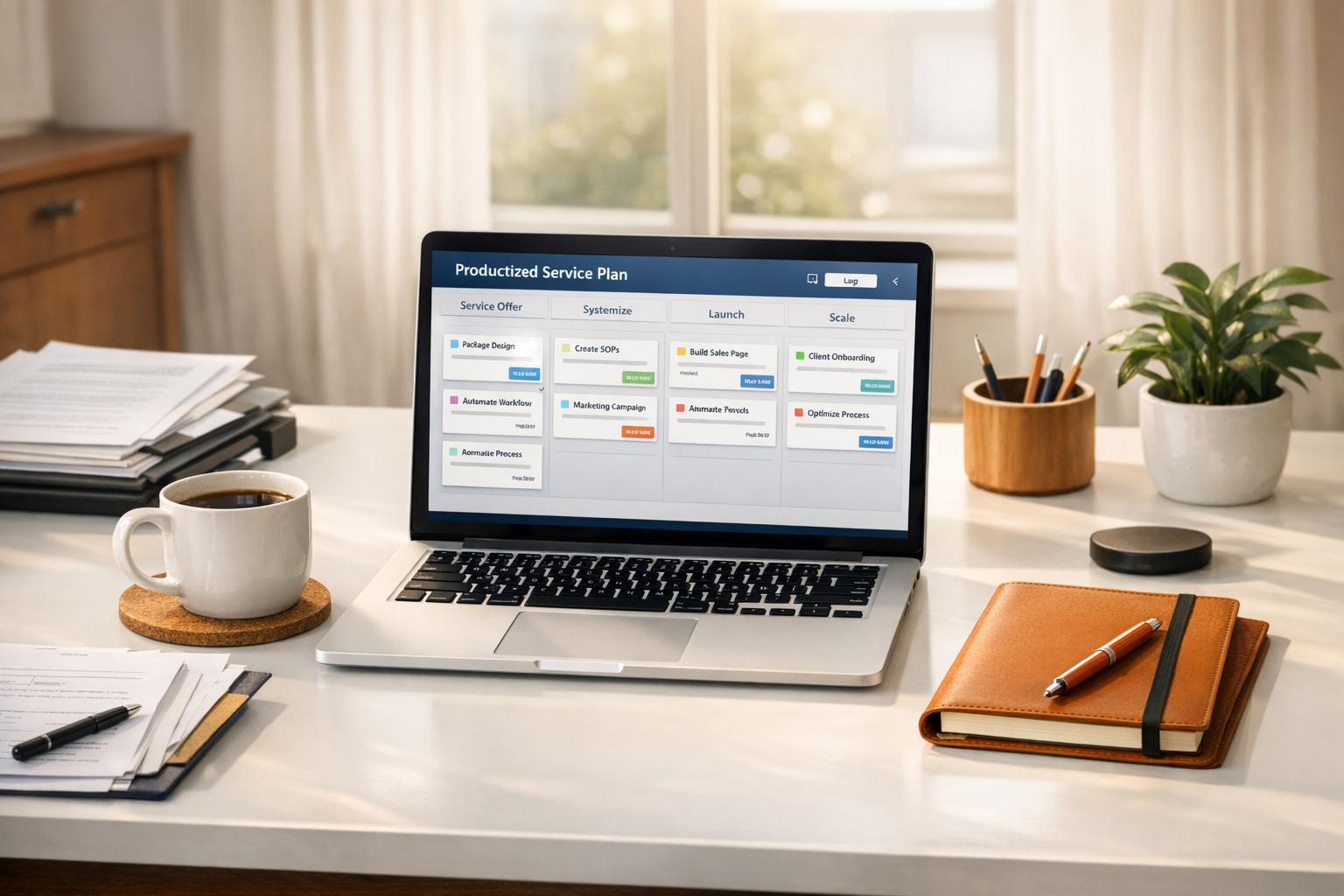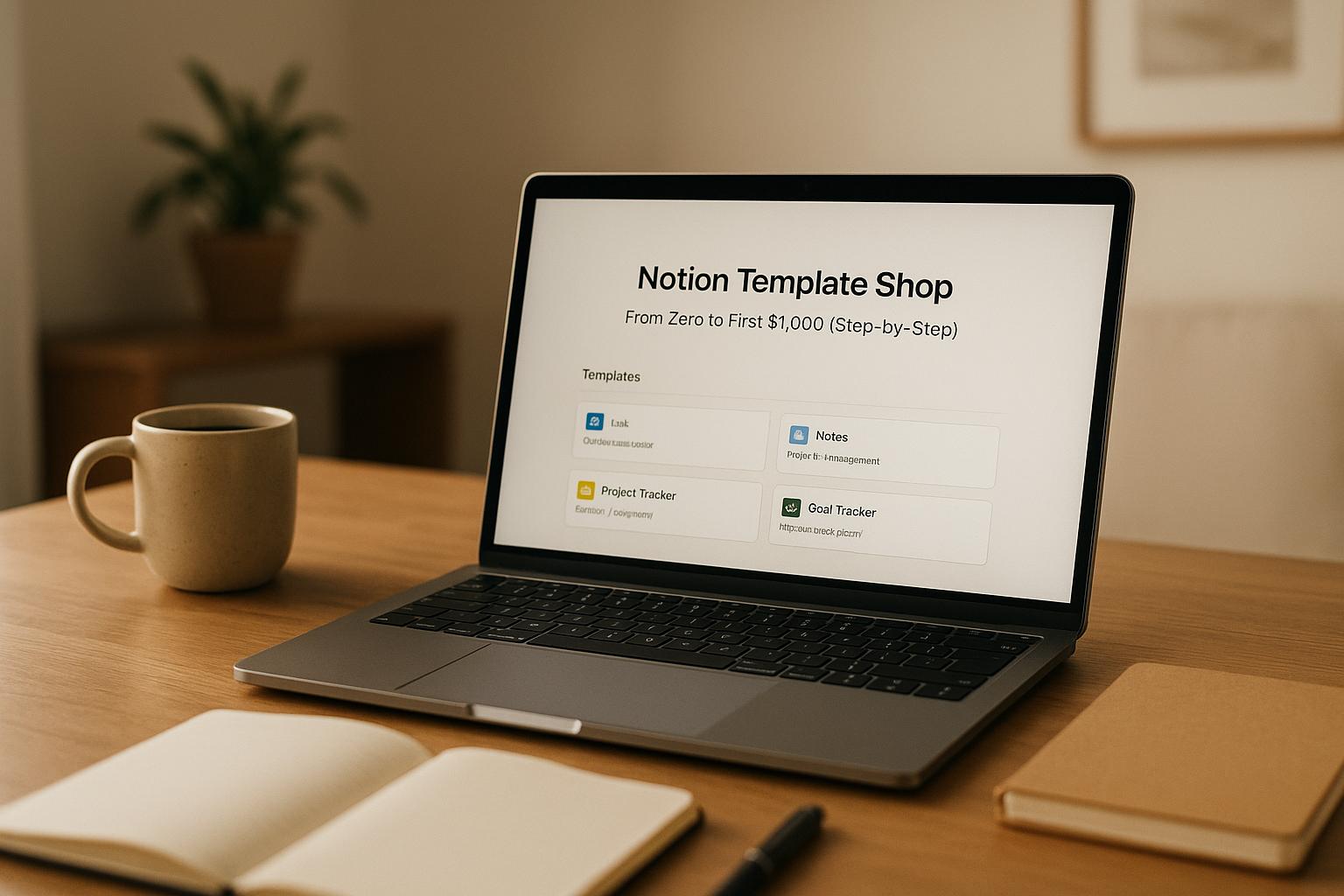
A business portfolio is your company's story told through results. It combines your identity, values, and achievements to show why clients and investors should work with you. A strong portfolio builds trust by using data-backed examples, customer testimonials, and financial metrics to prove your business delivers results. Here's what you need to know:
- Why portfolios work: They reduce uncertainty by showcasing measurable successes and industry credibility, making it easier for prospects to act.
- How to create one: Use AI tools like IdeaFloat to analyze your achievements, structure your portfolio, and highlight data that resonates with your audience.
- Tailoring for impact: Customize your portfolio for clients or investors with clear messaging, polished design, and relevant case studies.
- Pricing strategies: Offer tiered, subscription, or value-based pricing models that align with market data and customer needs.
Your portfolio isn’t just about presentation - it’s a tool to convert leads into customers and attract investors by demonstrating your value clearly and effectively.
How to Structure a Business Portfolio for Conversions
Key Considerations for an Effective Portfolio
There’s no one-size-fits-all formula for a successful portfolio. The goal is to clearly communicate what your business offers and why it’s important. Use straightforward language to address your audience’s concerns, highlighting your unique strengths, services, and pricing. This transparency builds trust and helps potential clients or investors quickly understand your value.
Once your messaging is clear, focus on design. A polished presentation should bring attention to the most important details without overwhelming the viewer.
Formatting and Presentation Best Practices
In the U.S., professionalism and clarity are highly valued, so your portfolio should reflect these traits. Opt for clean layouts with plenty of white space, clear headers, and bullet points to make your content easy to scan. Use visual elements sparingly but effectively to guide the reader’s eye.
Here are a few key tips for formatting:
- Use commas for large numbers and precede them with a dollar sign (e.g., $1,250,000).
- Stick to the MM/DD/YYYY format for dates.
- Round metrics to one decimal place for simplicity.
A strong visual hierarchy is essential. Consistent fonts, logical section breaks, and well-organized content make your portfolio more engaging. To maximize accessibility, offer both PDF and web versions; many professionals switch between devices when reviewing documents.
Tailoring Your Portfolio for Different Audiences
Even the best portfolio won’t convert if it doesn’t resonate with its audience. Tailor your content to match the needs of the people you’re addressing.
For potential clients, focus on how your services solve their specific problems. Use a conversational tone and real-world examples to show the practical benefits of working with you.
When targeting investors, shift the focus to your strategic vision. Highlight long-term growth opportunities, scalability, and the market potential of your business. This approach demonstrates that you understand their priorities while reinforcing your credibility.
Case Studies: Business Success with AI-Powered Portfolios
Case Study: Setting Better Pricing for a Service Business
A digital marketing agency in Denver, Colorado, had been relying on gut feelings to set its service prices. Realizing this approach wasn't cutting it, they turned to AI-powered pricing research tools to gain a clearer picture of their competitive landscape. These tools analyzed data from agency websites, service listings, and proposal documents, uncovering a key insight: the agency's premium services were priced lower than similar offerings from competitors.
With this information, the agency revamped its pricing strategy, creating tiered packages that catered to a range of client needs - from basic options to comprehensive enterprise solutions. This restructuring not only clarified the agency's value but also allowed them to tap into market segments they had previously missed.
The results were striking. The agency saw increases in average deal size, conversion rates, and monthly recurring revenue. This example shows how adopting AI-driven pricing tools can lead to smarter strategies, stronger market positioning, and real business growth. It’s a clear reminder of the power of data in shaping effective pricing and improving overall performance.
Examples of Great Case Studies to Follow
sbb-itb-08dd11e
Pricing Strategies That Convert: Examples and Templates
Getting your pricing strategy right can make or break your business. It’s not just about picking numbers - it’s about presenting value, structuring options effectively, and meeting customer expectations in the US market.
Common Pricing Models for US Businesses
When it comes to pricing, the structure you choose can significantly influence how customers perceive your services or products. Here are some widely used models that work well for US businesses:
- Tiered Pricing: This model breaks options into levels, such as basic, premium, and enterprise. It gives customers flexibility and a clear path to upgrade as their needs grow.
- Subscription Pricing: Perfect for recurring revenue, this model often includes monthly billing for smaller commitments or discounted annual plans to boost cash flow.
- Value-Based Pricing: Instead of charging for time or resources, this approach focuses on the outcomes you deliver, making it especially attractive in markets where ROI is the top priority.
- Freemium Model: Common for digital products, this strategy offers a free version to hook users while reserving premium features for paid plans.
Using AI to Set Better Pricing
AI is reshaping how businesses approach pricing decisions. Gone are the days of relying solely on gut instinct or outdated competitor comparisons. AI tools now analyze real-time market data to pinpoint the most effective price points.
Take IdeaFloat's Advanced Pricing Research, for example. This platform scans competitor websites, service listings, and broader market trends to uncover pricing gaps and opportunities. It applies data-driven insights to help businesses fine-tune their strategies, balancing higher conversion rates with healthy profit margins.
By analyzing factors like competitor pricing, customer willingness to pay, and psychological price anchoring, AI removes guesswork and emotional bias from your decision-making. This means you’re not just setting prices - you’re identifying the sweet spots that maximize both value for your customers and revenue for your business.
Sample Pricing Templates
Here are a few pricing templates tailored to different industries in the US. Use them as a starting point, and tweak the details to fit your business and market.
Service Business Template (Marketing Agency)
- Starter Package: $2,500/month – Includes social media management, basic reporting, and 10 posts per platform.
- Growth Package: $5,000/month – Adds paid advertising management, advanced analytics, and monthly strategy calls to the Starter Package.
- Enterprise Package: $10,000/month – Offers full-service marketing, a dedicated account manager, custom reporting, and quarterly business reviews.
SaaS Product Template (Project Management Tool)
- Basic Plan: $15/user/month (billed monthly) or $12/user/month (billed annually) – Includes core features, 5GB storage, and email support.
- Professional Plan: $35/user/month (billed monthly) or $28/user/month (billed annually) – Adds advanced tools, 100GB storage, priority support, and integrations.
- Enterprise Plan: $65/user/month (billed monthly) or $52/user/month (billed annually) – Offers unlimited storage, dedicated support, custom integrations, and single sign-on (SSO).
Consulting Business Template (Business Strategy)
- Strategy Session: $500 – A single 2-hour session with actionable recommendations.
- Monthly Retainer: $3,000/month – Includes 10 hours of consulting, a monthly strategic review, and email support.
- Project-Based Package: $15,000–$50,000 – Covers comprehensive strategic planning with 90-day implementation support.
The secret to making these templates work is customization. Adjust the pricing and features based on your market, client feedback, and the unique value your business brings.
Each template is designed to offer flexibility, with monthly and annual options and clear differentiation between tiers. The middle tier is often positioned as the "best value" to attract a wider audience, while enterprise-level packages allow room for negotiation and personalization - key for closing larger deals without compromising your pricing structure.
Tailor these models to highlight what makes your business stand out, and you’ll be well on your way to crafting a pricing strategy that resonates with your audience.
Practical Tips and Portfolio Templates
Create a portfolio that delivers results by following these actionable steps.
Step-by-Step Guide to Building Your Portfolio
Building an effective business portfolio begins with understanding your audience and assembling the right data. By breaking the process into manageable steps, you can create a portfolio that resonates with your target audience.
- Research your audience with IdeaFloat's Consumer Insights. Learn their language, understand their challenges, and use this as the foundation of your portfolio.
- Compile market research, competitor analysis, and financial projections using IdeaFloat's Smart Market Sizing. A strong portfolio is backed by solid data that supports your business case.
- Craft a clear value proposition. Use the insights from your research to address specific pain points and explain how your solution stands out from the competition.
- Develop pricing strategies with IdeaFloat's Advanced Pricing Research. Balance profitability with market expectations by relying on data-driven insights.
- Prepare financial projections and a business model. Include detailed revenue forecasts, cost breakdowns, and profit timelines. If possible, show multiple scenarios and be ready to explain your assumptions - investors and clients will appreciate your financial clarity.
- Customize your design for your audience. For clients, focus on case studies and testimonials. For investors, highlight market opportunities and financial scalability.
To make this process even easier, use the templates below to streamline your efforts.
Ready-to-Use Portfolio Templates
Instead of starting from scratch, take advantage of ready-made templates tailored for US businesses. These templates can save time while ensuring a professional look.
Explore platforms like Canva, Flipsnack, or Etsy for customizable options. Canva offers thousands of free, drag-and-drop templates, while Flipsnack specializes in professional designs for small businesses. Etsy provides over 5,000 templates ranging from $4.23 to $24.95, perfect for creating polished, corporate-ready portfolios.
Key sections to include in your US business portfolio:
- Executive Summary: A concise one-page overview of your business concept, target market, competitive edge, and financial highlights.
- Market Analysis: Include your total addressable market (TAM), serviceable addressable market (SAM), and serviceable obtainable market (SOM) with credible data.
- Value Proposition: Clearly explain what sets your business apart and why customers should choose you.
- Pricing Strategy: Provide pricing models backed by thorough market research, and include comparison charts if applicable.
- Financial Projections: Lay out 3-5 year revenue and expense forecasts, break-even analysis, and funding requirements.
- Implementation Timeline: Highlight key milestones, launch dates, and growth phases, complete with deadlines and deliverables.
Tips for Customizing Portfolios for Specific Goals
Once your portfolio framework is in place, tailor it to suit specific objectives.
For client acquisition, emphasize case studies, testimonials, and measurable results you've delivered for similar businesses. Include service details, pricing packages, and clear next steps to guide potential clients toward working with you.
For investor presentations, focus on market potential, scalability, competitive advantages, and financial returns. Investors are looking for growth opportunities and execution plans, so include detailed financial models, a robust market analysis, and a clear breakdown of funding needs.
For partnership opportunities, highlight complementary strengths, mutual benefits, and specific collaboration ideas. Show how a partnership with your business can create value and expand market reach for both parties.
Adapt your tone and language to fit your audience. For instance, tech investors may expect different terminology than small business lenders, while clients in creative industries might prioritize visually engaging designs over data-heavy presentations.
Match your format to audience expectations. Creative fields often prefer visually striking, design-forward portfolios, while industries like finance may favor clean, data-centric presentations with minimal graphics.
Include regulatory and compliance details when relevant. For US-based audiences, this could mean listing business licenses, insurance coverage, certifications, or compliance with industry regulations.
Use US-specific examples and case studies to connect with your audience. Referencing familiar companies, practices, and market conditions can make your portfolio more relatable and impactful.
Focus on what matters most to your audience and make those elements the centerpiece of your portfolio.
Conclusion: Build Portfolios That Drive Results
A business portfolio is more than just a collection of documents - it’s your chance to turn potential clients into loyal customers and attract investors who believe in your vision. The key to creating a portfolio that delivers results lies in blending solid data, polished presentation, and clear communication.
Start with a foundation of research and market intelligence. Backing your portfolio with credible data transforms vague promises into tangible business potential. For example, presenting pricing strategies and financial forecasts that reflect market trends shows professionalism and builds trust. This groundwork sets the stage for a visually appealing design that leaves a lasting impression.
The way your portfolio looks matters. A clean, organized layout signals professionalism and reliability at first glance. Whether you use a simple template or invest in a custom design, your portfolio should resonate with your audience. Different industries have different expectations - creative fields may lean toward bold visuals, while finance or tech might favor straightforward, data-driven formats. Once your design is set, make sure your messaging aligns with what your audience values most.
Next, tailor your portfolio to the needs of specific audiences. For clients, case studies and testimonials can demonstrate your track record and build credibility. For investors, focus on market opportunities and scalability to show long-term potential. This isn’t about creating entirely different portfolios but about fine-tuning your content to reflect what matters most to each group. Understanding their decision-making process is key.
Finally, tie everything together with clear communication. Your value proposition should jump off the page, and your pricing and financial details should be easy to understand and compelling. Avoid cluttering your portfolio with jargon - focus on clarity and include actionable next steps to guide your audience toward working with you. When all these elements come together, your portfolio becomes a powerful tool that inspires action and drives results.
FAQs
How can I use AI tools like IdeaFloat to create a standout business portfolio?
Creating a polished and engaging business portfolio has never been simpler, thanks to AI tools. Take IdeaFloat, for example - it simplifies the process by generating sleek designs and layouts tailored to your specific needs, cutting down on the time and effort required.
With AI, you can effortlessly organize your work into an eye-catching format, adapt content to suit different audiences, and even include clear pricing strategies. These tools let you focus on highlighting what sets you apart, ensuring your portfolio looks professional and leaves a lasting impression.
What key elements should a business portfolio include to attract clients and investors?
A well-crafted business portfolio serves as a window into your company’s products, services, and brands, while also providing a snapshot of your past projects, business strategy, and performance metrics. It’s your chance to emphasize what sets you apart and the unique value you offer, helping to build trust and credibility.
To make your portfolio stand out, consider including case studies or success stories that showcase your expertise and the results you’ve achieved. Transparent pricing strategies tailored to your audience can also go a long way in reinforcing trust. A thoughtfully organized portfolio not only highlights your strengths but also instills confidence in potential clients and investors.
How can I use AI insights to create an effective pricing strategy for my business?
To build an effective pricing strategy using AI, start by clarifying your goals. Are you aiming to increase revenue, improve profit margins, or capture a larger share of the market? AI can process massive amounts of data to spot trends, track competitors' pricing, and forecast customer behavior, giving you the tools to make informed pricing decisions.
AI also helps you segment your customers, allowing for tailored pricing strategies that resonate with specific groups. It enables dynamic pricing adjustments based on factors like market trends or inventory levels. On top of that, AI can fine-tune your promotions by identifying which discounts generate the most profitable results. These insights empower you to create competitive and flexible pricing that not only supports your business objectives but also connects with your audience.
Related Blog Posts
Get the newest tips and tricks of starting your business!


